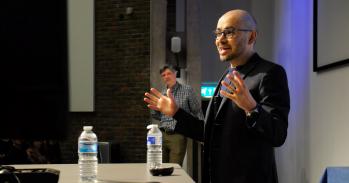
War diaries, scrapbooks, letters and photographs belonging to Sir John Cockcroft, Nobel Prize winner and one of the most influential scientists of the modern era, will today be placed in the care of the Churchill Archives Centre.
War diaries, scrapbooks, letters and photographs belonging to Sir John Cockcroft, Nobel Prize winner and one of the most influential scientists of the modern era, will today be placed in the care of the Churchill Archives Centre.
Cockroft's work has had a lasting legacy which continues to influence us all. This new material will sit alongside his existing scientific papers in the Archives Centre and will enable future generations to know the man behind the scientist.
Athene Donald
Sir John Cockcroft was one of the most important and influential scientists of the modern era. He was the joint winner of the Nobel Prize for Physics (1951) for his pioneering work at the Cavendish Laboratory on the disintegration of atoms (splitting the atom).
His research facilitated the development of atomic power, nuclear medicine and accelerator science. He was the first Director of the British Atomic Energy Research Establishment at Harwell, and the first Master of Churchill College, Cambridge.
This evening, several generations of the Cockcroft family, including Sir John’s surviving children, will gather at Churchill College to celebrate the 120th anniversary of Sir John’s birth and the 50th of his death.
They will mark the occasion by handing over to the Churchill Archives Centre a family treasure trove of scrapbooks, photograph albums and hitherto unseen diaries and letters from the Western Front of World War One, illustrating the personal life of this most public scientist.
Here, it will join his Nobel Prize medal and complement his scientific papers, including his notebooks for his ground-breaking experiments which are already housed at the Archive Centre. The new material includes 400 letters to his fiancée from 1915-1919, along with a mass of later correspondence, including letters to his mother during his high powered scientific roles in the Second World War.
Other highlights include:
- Scrapbooks containing material on the Tizard mission (1940) which gave the Americans, on Churchill's orders, our scientific secrets regarding the possibility of making an atomic bomb and the newly invented cavity magnetron. Sir Henry Tizard led the mission with John Cockcroft as his deputy.
- Gamov's letter to Cockcroft of 7th September 1932, congratulating him on his discovery (first artificial disintegration of atomic nuclei).
- Sir John’s WW1 diaries from the Western Front.
After completing his first year at Manchester University, John Cockcroft left home in the summer of 1915 during World War One. Too young to enlist, he first worked as a YMCA volunteer in an Army Camp at Abergele. In 1916 he joined the Royal Field Artillery (RFA) as a Private. He became a signaller in the RFA and was sent to France to join the latter stages of the Battle of the Somme.
Subsequently he moved in July 1917 for the 3rd Battle of Ypres, known as Passchendaele. He survived unscathed throughout, even though many fellow soldiers in his Battery were killed or wounded. Early in 1918 he went back to England to train as an officer, which is where he was when the war ended in November 1918.
A complete set of nearly 400 letters home exist covering the whole of this period. Together they amount to a wonderfully descriptive and insightful account of unstinting service to his country. In addition there are some pocket diaries which he kept, despite regulations forbidding them.
Dame Athene Donald, Master of Churchill College, said: “Both as Master and as professor of Experimental Physics at the University of Cambridge, I am conscious that I owe a great personal debt to Sir John. But it is fair to say that his work has had a lasting legacy which continues to influence us all. This new material will sit alongside his existing scientific papers in the Archives Centre and will enable future generations to know the man behind the scientist.”
Christopher Cockcroft, Sir John’s son, said, “The time was right for the family to share this material and for it to be conserved for future generations to learn the full story of this remarkable man: a secondary school boy from Todmorden, who survived the First World War, and worked his way to the top of his profession; a man who firmly believed in the fellowship of man and did much to foster understanding between people and nations.”
Michael Smyth, author of a forthcoming biography of Sir John, highlighted the set of scrapbooks kept by Sir John’s mother and the many letters to his wife which together provide a unique insight into his life.
The reception and handover will take place in the Jock Colville Hall, Churchill College at from 6pm on Friday evening (September 22). All are welcome. The event will mark the beginning of the Churchill College Alumni Association Weekend, and will be the first of several events during the weekend celebrating Sir John’s life and legacy.
See https://www.chu.cam.ac.uk/events/churchill-college-association-weekend-2... for further details.

The text in this work is licensed under a Creative Commons Attribution 4.0 International License. For image use please see separate credits above.




